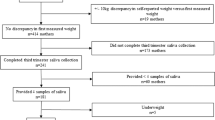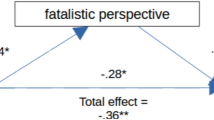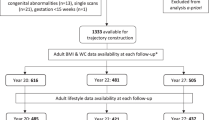Abstract
Background:
This exploratory study investigates the influence of maternal cortisol and emotional state during pregnancy on fetal intrauterine growth (IUG). We expected higher basal cortisol levels, or more depressive and anxious complaints during pregnancy, to be associated with slower IUG and lower birth weight.
Methods:
A total of 91 pregnant women were recruited from the antenatal clinic and were seen once each trimester. In addition to psychological assessments, a diurnal cortisol profile was derived from saliva samples. IUG was evaluated using ultrasound.
Results:
In mid-pregnancy (trimester (T)2), basal cortisol levels significantly predicted the variance of weight (proportion of variance in growth variable explained (PVE) = 11.6%) and body mass index (BMI) at birth (PVE = 6.8%). In late pregnancy (T3) emotional state, particularly depressive symptoms (BMI at birth: PVE = 6.9%; ponderal index (PI) at birth: PVE = 8.2%; head circumference at T3: PVE = 10.3%; head circumference at birth PVE = 9.1%) and attachment (BMI at birth: PVE = 6.9%; PI at birth: PVE = 7.2%) had an influence on growth. Analysis of growth between T2 and T3 showed that attachment and cortisol in T3 had an influence on the variation in increase in estimated fetal weight (PVE = 12.5–8.6%).
Conclusion:
These data indicate basal cortisol levels were more important in T2 whereas emotional state was more important in T3.
Similar content being viewed by others
Log in or create a free account to read this content
Gain free access to this article, as well as selected content from this journal and more on nature.com
or
References
Wadhwa PD, Buss C, Entringer S, Swanson JM . Developmental origins of health and disease: brief history of the approach and current focus on epigenetic mechanisms. Semin Reprod Med 2009;27:358–68.
Eriksson J . Patterns of growth: relevance to developmental origins of health and disease. In: Gluckman PD, Hanson MA, eds. Developmental Origins of Health and Disease. Cambridge, UK: Cambridge University Press, 2006:223–232.
Glover V, O’Connor TG, O’Donnell K . Prenatal stress and the programming of the HPA axis. Neurosci Biobehav Rev 2010;35:17–22.
Gitau R, Fisk NM, Teixeira JM, Cameron A, Glover V . Fetal hypothalamic-pituitary-adrenal stress responses to invasive procedures are independent of maternal responses. J Clin Endocrinol Metab 2001;86:104–9.
Sarkar P, Bergman K, Fisk NM, Glover V . Maternal anxiety at amniocentesis and plasma cortisol. Prenat Diagn 2006;26:505–9.
Bertram CE, Hanson MA . Prenatal programming of postnatal endocrine responses by glucocorticoids. Reproduction 2002;124:459–67.
Pinto ML, Shetty PS . Influence of exercise-induced maternal stress on fetal outcome in Wistar rats: inter-generational effects. Br J Nutr 1995;73:645–53.
Lesage J, Del-Favero F, Leonhardt M, et al. Prenatal stress induces intrauterine growth restriction and programmes glucose intolerance and feeding behaviour disturbances in the aged rat. J Endocrinol 2004;181:291–6.
Rahman A, Bunn J, Lovel H, Creed F . Association between antenatal depression and low birthweight in a developing country. Acta Psychiatr Scand 2007;115:481–6.
Nordentoft M, Lou HC, Hansen D, et al. Intrauterine growth retardation and premature delivery: the influence of maternal smoking and psychosocial factors. Am J Public Health 1996;86:347–54.
Andersson L, Sundström-Poromaa I, Wulff M, Aström M, Bixo M . Neonatal outcome following maternal antenatal depression and anxiety: a population-based study. Am J Epidemiol 2004;159:872–81.
Evans J, Heron J, Patel RR, Wiles N . Depressive symptoms during pregnancy and low birth weight at term: longitudinal study. Br J Psychiatry 2007;191:84–5.
Bhagwanani SG, Seagraves K, Dierker LJ, Lax M . Relationship between prenatal anxiety and perinatal outcome in nulliparous women: a prospective study. J Natl Med Assoc 1997;89:93–8.
McDonald RL . The role of emotional factors in obstetric complications: a review. Psychosom Med 1968;30:222–43.
Littleton HL, Bye K, Buck K, Amacker A . Psychosocial stress during pregnancy and perinatal outcomes: a meta-analytic review. J Psychosom Obstet Gynaecol 2010;31:219–28.
Gaynes BN, Gavin N, Meltzer-Brody S, et al. Perinatal depression: prevalence, screening accuracy, and screening outcomes. Evid Rep Technol Assess (Summ) 2005;119:1–8.
Andersson L, Sundström-Poromaa I, Wulff M, Aström M, Bixo M . Depression and anxiety during pregnancy and six months postpartum: a follow-up study. Acta Obstet Gynecol Scand 2006;85:937–44.
Schulte HM, Weisner D, Allolio B . The corticotrophin releasing hormone test in late pregnancy: lack of adrenocorticotrophin and cortisol response. Clin Endocrinol (Oxf) 1990;33:99–106.
de Weerth C, Buitelaar JK . Cortisol awakening response in pregnant women. Psychoneuroendocrinology 2005;30:902–7.
Levine A, Zagoory-Sharon O, Feldman R, Lewis JG, Weller A . Measuring cortisol in human psychobiological studies. Physiol Behav 2007;90:43–53.
Obel C, Hedegaard M, Henriksen TB, Secher NJ, Olsen J, Levine S . Stress and salivary cortisol during pregnancy. Psychoneuroendocrinology 2005;30:647–56.
Diego MA, Jones NA, Field T, et al. Maternal psychological distress, prenatal cortisol, and fetal weight. Psychosom Med 2006;68:747–53.
Henrichs J, Schenk JJ, Roza SJ, et al. Maternal psychological distress and fetal growth trajectories: the Generation R Study. Psychol Med 2010;40:633–43.
Kivlighan KT, DiPietro JA, Costigan KA, Laudenslager ML . Diurnal rhythm of cortisol during late pregnancy: associations with maternal psychological well-being and fetal growth. Psychoneuroendocrinology 2008;33:1225–35.
Gale CR, O’Callaghan FJ, Bredow M, Martyn CN; Avon Longitudinal Study of Parents and Children Study Team. The influence of head growth in fetal life, infancy, and childhood on intelligence at the ages of 4 and 8 years. Pediatrics 2006;118:1486–92.
Ishimoto H, Jaffe RB . Development and function of the human fetal adrenal cortex: a key component in the feto-placental unit. Endocr Rev 2011;32:317–55.
Hadlock FP, Harrist RB, Carpenter RJ, Deter RL, Park SK . Sonographic estimation of fetal weight. The value of femur length in addition to head and abdomen measurements. Radiology 1984;150:535–40.
Devlieger H, Martens G, Bekaert A, Eeckels R. Standards for birthweight adjusted for gestational age in the flemish newborn. Tijdschr voor geneeskunde 2000;56:1–14.
Laboratorium voor antropogenetica Vrije Universiteit Brussel. Flemish growth charts 2004. (http://www.vub.ac.be/groeicurven/english.html.) Accessed 4 July 2006.
Cox JL, Holden JM, Sagovsky R . Detection of postnatal depression. Development of the 10-item Edinburgh Postnatal Depression Scale. Br J Psychiatry 1987;150:782–6.
Zigmond AS, Snaith RP . The hospital anxiety and depression scale. Acta Psychiatr Scand 1983;67:361–70.
Simons A, Van den Bergh BR. Maternal fears in pregnancy. Poster presentation “Conference of Emotions” 22–24 October 2007, Tilburg, The Netherlands.
van Bussel JC, Spitz B, Demyttenaere K . Anxiety in pregnant and postpartum women. An exploratory study of the role of maternal orientations. J Affect Disord 2009;114:232–42.
Cranley MS . Development of a tool for the measurement of maternal attachment during pregnancy. Nurs Res 1981;30:281–4.
Michiels L, Van den Eynden K. Angst tijdens de zwangerschap? Conceptuele beschrijving en interventiestrategieën. [Anxiety during pregnancy: a specific phenomenon? Conceptual description and intervention strategies.] Dissertation to obtain a degree of license in psychology. Leuven, Belgium, 2006.
Author information
Authors and Affiliations
Corresponding author
Rights and permissions
About this article
Cite this article
Hompes, T., Vrieze, E., Fieuws, S. et al. The influence of maternal cortisol and emotional state during pregnancy on fetal intrauterine growth. Pediatr Res 72, 305–315 (2012). https://doi.org/10.1038/pr.2012.70
Received:
Accepted:
Published:
Issue date:
DOI: https://doi.org/10.1038/pr.2012.70
This article is cited by
-
Long-Term Associations Between Prenatal Maternal Cortisol and Child Neuroendocrine-Immune Regulation
International Journal of Behavioral Medicine (2020)
-
Adult attachment style and cortisol responses in women in late pregnancy
BMC Psychology (2016)



